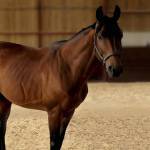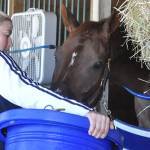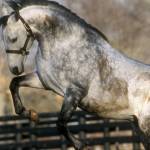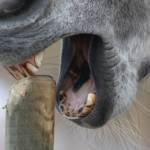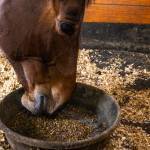Wearable Glucose Sensor Helps Diagnose Insulin Resistance in Horses

In human medicine, diabetic patients can monitor their blood glucose levels using wearable devices such as the FreeStyle Libre. This device was recently tested in horses, and researchers found that this instantaneous continuous glucose monitoring system can be used in horses, eliminating the need for repeated blood sample collection.*
“A continuous glucose monitoring system would be helpful, especially in certain diagnostic situations, such as when veterinarians choose to run a combined glucose-insulin test,” explained Ashley Fowler, Ph.D., a Kentucky Equine Research nutritionist.
This test, abbreviated the CGIT, helps diagnose insulin resistance in horses. For this test, researchers administer intravenous dextrose and insulin, and then take repeated blood samples to measure both glucose and insulin for 150 minutes, requiring about 14 blood draws in total.
“Using a noninvasive wearable blood glucose monitoring system reduces patient stress and eliminates the risks associated with repeated blood collections during the CGIT,” Fowler said.
The FreeStyle Libre measures “interstitial glucose,” which is the glucose found in the fluid surrounding cells under the skin rather than directly measuring glucose levels in the bloodstream.
To determine whether the FreeStyle Libre could be used accurately in horses, 10 stallions from a single private farm were recruited. Each horse had a wearable blood glucose monitor placed on the side of its neck just below the poll.
On day one of the study, blood samples were collected on all horses over a 10-hour period, and those blood sugar levels were compared to the glucose values obtained using the FreeStyle Libre.
Good agreement was found using the two methods, and 99% of the glucose values obtained using the FreeStyle Libre fell into the “analytical accuracy zone.” According to the researchers, these findings support using this device in horses.
On day four of the study, five obese horses (body condition score of 7 or more) underwent a CGIT using both the FreeStyle Libre and traditional blood glucose analysis. Based on those results, the FreeStyle Libre was deemed appropriate for glucose measurements during the CGIT.
“Ultimately the goal is to use a continuous glucose monitoring system like the FreeStyle Libre in a field setting for the CGIT and other applications, including research,” said Fowler.
In this study, the FreeStyle Libre was quickly and easily applied, well tolerated, pain-free, and the sensors remained in place for an average of four days.
“Given the increased awareness regarding insulin dysregulation and equine metabolic syndrome, more horses could benefit from insulin function tests. The CGIT is a good test, but often is difficult to perform in the field due to the multiple blood samples required. Using a continuous monitoring system would simplify field testing,” Fowler explained.
For horses diagnosed with insulin dysregulation, feed hay low in nonstructural carbohydrates (less than 10%), and add a balancer pellet to ensure optimal nutrition is met. Most hays appropriate for horses with insulin dysregulation would not confer sufficient protein, so a balancer pellet may be necesssary.
“Some horses may also benefit from adding EO-3, a potent source of the omega-3 fatty acids EPA and DHA, to their diet to improve insulin sensitivity,” Fowler added.
*Françoso, R., R.Y. Baccarin, R.F. de Siqueira, and C.B. Belli. 2024. Use of FreeStyle Libre for continuous glucose monitoring in adult horses. Journal of Veterinary Emergency and Critical Care (San Antonio):13367.

